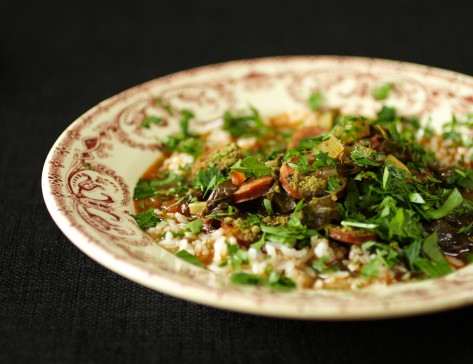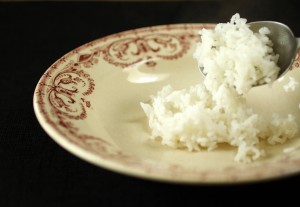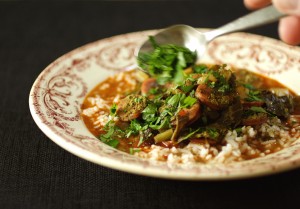Crescent Dragonwagon’s Gumbo Zeb

Filé powder. Dark chocolate-brown roux. Cayenne pepper. These are the some of the ingredients that help give gumbo its signature and soul-satisfying flavor. When I discovered that Crescent Dragonwagon devoted an entire chapter in her cookbook Dairy Hollow House Soup & Bread to this distinctively, and to Northerners, exotic, American soup, I knew I would want to try my hand at making a pot of gumbo before the club moved on to the next book. Having followed Crescent’s very detailed and clear instructions, I’m convinced that anyone can make a good gumbo. The making of an authentic gumbo is not to be taken lightly; it is very involved, but I assure you it is worth the work.
In the gumbo chapter, called “Gumbo Zeb,” after the version she finally settled on after trying twenty-one different gumbo recipes, Crescent gives a fascinating history of the development of the soup, starting with filé powder—made from ground dried sassafras leaves—a seasoning used by the Choctaw Indians. She then describes how she arrived at her version in an interesting recount of recipe development, from research, testing, and retesting. After the many months of refinement, and the positive feedback from customers (it became a Dairy Hollow House favorite), Crescent is completely confident of the excellence of her gumbo: “To say it’s good,” she writes, “is understatement, but to say how good it is, is bragging.” I don’t know of much more of an incentive to take on gumbo making than that.
To make Crescent’s delicious gumbo, first you must make her Gumbo Zeb Base, which is used in seven plus gumbo recipes. You will need lots of greens, quarts of stock, preferably homemade, a well-stocked spice drawer, and patience to make a proper dark roux. Once the stock and base are made, the gumbo recipe comes together fairly quickly. The recipe for the base makes more than you need for any given gumbo recipe in Dairy Hollow House Soup & Bread, but it freezes wonderfully, Crescent says. Given the work needed to make the base, the large yield makes sense—and how nice it will be to simply pull some lovingly created base and preferably homemade stock out of the freezer, and then, in practically no time flat, have a great bowl of gumbo ready to enjoy.
I’ve included the recipe for the base below and the gumbo that I tried, Andouille Gumbo Zeb. To get the whole gumbo backstory, and the benefit of Crescent’s detailed instruction and hand-holding tone, plus the full range of Crescent’s gumbo ideas for putting the Gumbo Zeb Base to good use, I highly recommend picking up Dairy Hollow House Soup & Bread. There’s lots of wonderful stuff in this book, but the gumbo chapter alone is worth owning a copy.
(From Dairy Hollow House Soup & Bread by Crescent Dragonwagon, with minor tweaks.)
Gumbo Zeb Base
For the roux:
1 cup mild vegetable oil, such as corn, canola, or soy
1 cup unbleached all-purpose flour
For the mirepoix:
1 stick butter (8 tablespoons)
2 large onions, chopped
2 green bell peppers, stemmed, seeded, and chopped
1 bunch celery with leaves, chopped
1 large bunch (8 to 10) scallions, chopped
For the seasoning purée:
8 cloves garlic, peeled
¼ cup Pickapeppa or Worcestershire sauce (I used Worcestershire)
¼ cup tomato paste
1 tablespoon Tabasco sauce
2 teaspoons dried basil
2 teaspoons dried oregano
2 teaspoons dried thyme
1 teaspoon paprika
Heaping ¼ teaspoon cayenne pepper
Heaping ¼ teaspoon ground allspice
Heaping ¼ teaspoon ground cloves
6 to 8 good grinds of black peppercorns
1 (16-ounce) can whole tomatoes, drained and coarsely chopped
1 bunch fresh Italian parsley, leaves and stems rinsed and coarsely chopped
For the stock and greens:
6 cups any well-flavored chicken or vegetable stock, or bottled clam juice (I used chicken stock)
2 cups tomato juice or V8 vegetable juice (I used tomato juice)
1 teaspoon salt
4 bay leaves
6 bunches greens (about 4½ to 5 pounds total), ideally 1 bunch each mustard greens, spinach, turnip greens, beet tops, collard greens, arugula, and watercress, very well washed and finely ribboned
1½ cups tomato or V8 vegetable juice (I used tomato juice)
1. Have all of the prep work done before beginning to make the Gumbo Zeb Base.
2. Make the roux: Pour the oil in a heavy bottomed pot or saucepan (Crescent uses cast-iron) and set over medium heat. Add the flour and whisk until fully incorporated and smooth. The color will be a pale cream to beige color. Stir often to keep the roux from burning, and constantly during the final cooking stage. During the early stage, you may move on to the next step—sautéing the mirepoix—but don’t forget about the roux. Check back frequently, stirring every few minutes or so.
As the roux cooks it will darken in color and begin to smell nutty and, if you go all the way to dark roux, like burnt popcorn. Roux making cannot be rushed: The entire process will take from 45 minutes to an hour or more. Crescent says she prefers her roux a shade or two beyond caramel. I went all the way—to a dark chocolate-brown roux.
When the roux becomes fairly brown, the oil will separate out partially from the flour. This is what you want. Crescent says not to take the roux off the heat before this point. After the oil has separated, how much longer to cook it is a matter of taste. The darker and nuttier it becomes, the richer the flavor. (A side note: As a roux cooks, the starch granules break down, diminishing the flour’s thickening capability. So, a darker roux will give you a more flavorful gumbo, but also a thinner one—okay by me.)
I found that the roux moved fairly quickly from beige to caramel or light brown, but progressing from the light brown to dark brown stage was slow going, and took the bulk of the cooking time. This is when patience and vigilance is required, especially if you’re going for dark roux. If just one black speck appears in the roux, you will need to throw it out and start over.
3. Sauté the mirepoix: In a heavy skillet, melt the butter over medium heat. Add the onions, and sauté until softened, 5 to 6 minutes. Add the bell peppers and celery; lower the heat slightly and continue sautéing another 10 minutes. Add the scallions, and sauté until limp, about 5 minutes more. While the mirpoix is sautéing, prepare the seasoning puree, but remember to keep checking the roux and stirring it. Once the vegetables are softened, remove them from the heat and set aside.
4. Prepare the seasoning purée: Place all the ingredients for the seasoning purée except the tomatoes and parsley in a food processor. Process until the garlic is chopped fine. Add the tomatoes and parsley to the food processor, and chop coarsely.
5. Check the roux: If it has become caramel-colored or darker, it’s time to give it your undivided attention. Jump to Step 7 for the final steps in preparing the roux. If it’s not yet caramel-colored, begin to prepare the stock and greens.
6. Prepare the stock and greens: This is the mixture into which the other three mixtures you’ve prepared—the roux, mirepoix, and seasoning purée—will go. In a large stockpot, bring the stock and tomato juice to a boil. Add the salt and bay leaves. Drop in the fresh greens. Bring back to a boil, then reduce the heat to medium-low and simmer, covered, about 30 minutes.
7. Finish the roux: When the roux is done to your liking, remove it from the heat and let cool for a few minutes. Drain off any excess oil that has separated out, but be careful not to pour off any of the browned flour. Vigorously whisk in the 1½ cups tomato juice. It will be a smooth and thick orange paste.
8. Complete the base: When the greens have finished their 30-minute simmer, remove them from the heat. To the stockpot, add the roux mixture, sautéed mirepoix, and the seasoning purée. Taste for seasoning and adjust, if needed. Set the pot over the lowest possible heat and let simmer, covered, another 15 minutes, stirring often.
Remove from the heat and let cool to room temperature. It is now ready to be used in Andouille Gumbo Zeb (below) or in any of the other gumbo recipes in Dairy Hollow House Soup & Bread. Leftover base can be frozen in small portions. Makes 5 to 6 quarts
Andouille Gumbo Zeb
Of the seven gumbo recipes Crescent offers, not counting the variations, I decided to make this one because I love Andouille sausage and because I’ve got a good source right here in Vermont: On the Edge Farm, owned by Bill and Dana Pape, in Woodstock. Their andouille is made with a combination of their own farm-raised beef and pork, and is smoked by Green Mountain Smokehouse in Windsor, Vermont.
1 to 1½ pounds andouille, sliced
6 cups Gumbo Zeb Base
5 to 6 cups any well-flavored chicken stock
1 cup or more cooked white rice
Filé powder
Finely chopped fresh parsley, for garnish
1. Fry the andouille in a skillet over medium heat until slightly browned and to cook out as much fat from the sausage as possible, about 5 minutes. Discard the fat and drain the sausage on paper towels.
2. In a large stockpot, bring the base, stock, and andouille to a boil. Reduce the heat to medium-low and let simmer gently, stirring occasionally, for 30 minutes.
3. To serve, place a mound of rice in each serving bowl,

ladle the hot gumbo over it,

sprinkle about ¼ teaspoon of the filé powder over each portion,

and garnish with the parsley.

Pass additional filé at table. (Note: There is a good reason why file is sprinkled on after cooking; according to authors of The Food Lover’s Companion, undue cooking makes its tough and stringy.)
For absolute contentment, serve with cornbread (click here and here for two cornbread recipes). Serves 4 to 6

This is an awesome recipe… A bit of effort and requires some planning but very rewarding results. I have been making this annually at Xmas since the book first came out.
1Thanks for your comment, Mark. Your comment may help convince yet one more person to try Crescent’s recipe. Which version do you make, by the way? There are so many. It freezes well, too! I’ve frozen the gumbo zeb base, and then continued from there, adding the chx stock, etc.
2I’ve made a number of variations depending on what looks good at the market. Once you have the base! You can pretty much do anything… Shrimp, crab, chicken etc etc. it does freeze very well. I generally covet the lest container of frozen base.
3And how amazing to get a burst of greens right in the middle of the winter! It sounds like making the base is an annual, seasonal event–making the base when the selections of fresh greens are in. Some put up pickles; you put up gumbo zeb base! I love it. Do you live in a part of the country where a wide selection of greens is available? Here in Vermont, it’s rare to find greens such as collards, turnip greens, or mustard greens. That is where a garden comes in handy. Have you used any greens that Crescent Dragonwagon doesn’t suggest, but found they work well?
4I love this recipe. I make this when the first deep frost is threatening my garden that way I have something to do with all those greens, celery etc. Then I can it in my pressure canner and we have warm spicy gumbo all winter long.
I have vegan, vegetarian, only fish eaters, meatlover friends so this is a great thing to serve to a group. I put nice little bowls of the additions of rice, prawns, chicken, sausage etc on the table for people to choose and everyone is happy.
5Isn’t it fantastic? I grew a bunch of greens in my garden this summer with this recipe in mind. What a wonderful idea to can it. Fantastic. And what a great idea to have a spread of different meats, etc. for people to add in as they wish. If one had to live on one recipe alone, this might be the one to pick.
6I’ve been making this gumbo zeb recipe for 20 years. It is absolutely wonderful. You will practically use every pan in the kitchen to make the base and soup, but it is so worth it. I love spending an afternoon in the kitchen on a gray, rainy day and just enjoying the process. I’ve made a number of versions of it, but my favorite is shrimp gumbo with andouille sausage. In fact, I’m defrosting a gallon freezer bag of stock in my refrigerator right now in order to make some for a college football party this Saturday. It is a commitment, but very well worth it.
7Jennifer, you put it better than I could. How true about using so many pots and pans, and about it all being worth it. You’ve made me want to get that recipe out again and get to it. You know, this recipe is one of the most commented on one on this blog, which says something about how well it is loved. (And to Crescent Dragonwagon’s genius.)
8This is my favorite gumbo recipe. My father is from Lake Charles, LA. My grandmother could make a fantastic gumbo. My father was also in the Air Force so we did not see my grandparents that often. When I got older I longed for the taste of my grandmothers cooking and searched for the recipe that would deliver that unmistakeable memory. After many misses and near misses I found the Gumbo Zeb recipe. It exceeded my craving and is now our go to recipe for Gumbo. This weekend we will spend the weekend in Eureka Springs, AR with friends making Gumbo and telling stories just down the street from the Dairy Hollow House.
9Chris, your story is wonderful. Gumbo clearly has so many good memories, and meaning, for you. That’s one of the best things about a recipe, I think–that it can recreate the taste of a memory while at the same time make new memories each time it is made. With your Louisiana roots, your praise of this recipe is one more feather in its cap (it’s already the most commented on and praised recipe on my blog). And how fitting that you’re making this gumbo in the town where it was created–I can’t say as much. (Though I did make it to Eureka Springs a couple of summers ago for a quick day visit–what a remarkably beautiful place!)
10I have been making this every couple of years since my daughter gave me the “Soup and Bread” book many years ago. I double the batch and pressure can it in quart jars as it keeps up to two years that way.
I am canning a batch right now.
11Fantastic! What a great way to start the year. I don’t believe there is a better recipe out there for gumbo–and that must be the case because this recpe seems to be the most beloved and most commented on on my site. I agree about doubling the recipe. It’s quite a bit of worthwhile work, so doubling makes sense. Thanks for sharing the tip about presssure canning it. I’ve only frozen it, so I’m glad to know that it cans well. (And it’s much safer! If the power goes out, no worries about losing precious gumbo.)
12